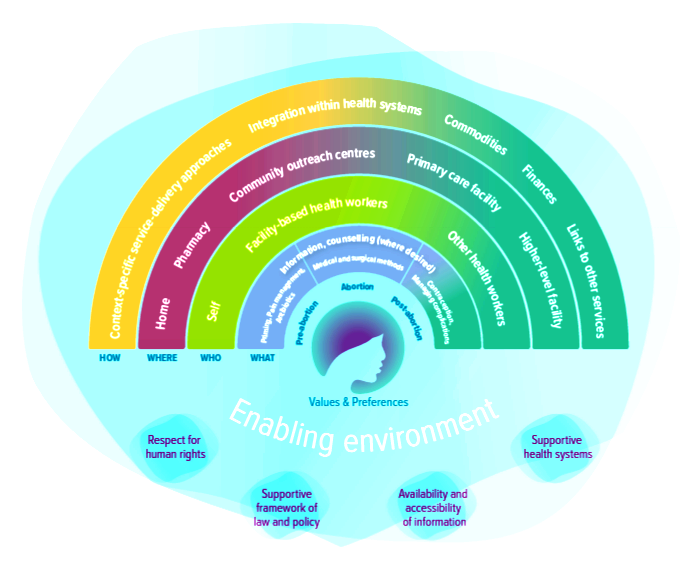Social Justice
New Guidelines on Abortion Care by WHO
- 14 Mar 2022
- 6 min read
For Prelims: Abortion, World Health Organization, Telemedicine.
For Mains: Issues Related to Women, Health, Human Resource, Important International Institutions, Guidlines of WHO on Abortion, Abortion related policies in India.
Why in News?
Recently, the World Health Organization (WHO) presented new guidelines on abortion care. These, it claimed, would prevent more than 25 million unsafe abortions annually.
- The new guidelines include recommendations on many simple interventions at the primary care level that improve the quality of abortion care provided to women and girls.
- The new guidelines will support interested countries to implement and strengthen national policies and programmes related to contraception, family planning and abortion services, helping them to provide the highest standard of care for women and girls.
What is the Global Status of Abortions?
- Globally, between 13,865 and 38,940 lives are lost yearly due to the failure to provide safe abortion.
- Developing countries bear the burden of 97% of unsafe abortions.
- The proportion of abortions that are unsafe is also significantly higher in countries with highly restrictive abortion laws than in those with less restrictive laws.
- Over half (53.8%) of all unsafe abortions occur in Asia, the majority of those in south and central Asia. A quarter (24.8%) occur in Africa, mainly in eastern and western Africa and a fifth (19.5%) in Latin America and the Caribbean.
- Abortion rates were highest in low-income countries with the most legal restrictions to abortion care.
- There was also an increase of 12% in the number of abortions in countries with legal restrictions on the procedure, while it declined slightly in countries where abortion is broadly legal.
What are the New Guidelines by the WHO?
- Task Sharing:
- These include task sharing by a wider range of health workers, ensuring access to medical abortion pills, which mean more women can obtain safe abortion services and making sure that accurate information on care is available to all those who need it.
- Telemedicine:
- It also includes the recommendations for the use of telemedicine, which helped support access to abortion and family planning services during the Covid-19 pandemic.
- Removing Political Barriers:
- It also recommend removing medically unnecessary political barriers to safe abortion, such as criminalisation, mandatory waiting periods before receiving a requested abortion, third-party authorisation for abortion, restrictions on which health workers can provide abortion services.
- Such barriers can lead to critical delays in accessing treatment and put women and girls at greater risk of unsafe abortion, stigma and health complications, while increasing barriers to education and their ability to work.
- Restricting access to abortions does not reduce the number of abortions that take place. In fact, restrictions are more likely to push women and girls into unsafe practices.
- Providing Enabling Environment:
- A person’s environment plays a crucial role in shaping their access to care and influencing their health outcomes.
- An enabling environment is the foundation of quality comprehensive abortion care.
- The three cornerstones of an enabling environment for abortion care are:
- Respect for human rights including a supportive framework of law and policy.
- Availability and accessibility of information.
- A supportive, universally accessible, affordable and well functioning health system.
What are the Steps Taken by the Indian Government for Safe Abortions?
- The Government provides safe and Comprehensive Abortion Care (CAC) services to women in health facilities under RMNCH+A (Reproductive, Maternal, Newborn, Child and Adolescent Health) program of National Health Mission.
- Capacity Building of Medical officers in Safe Abortion Techniques and of Auxiliary Nurse Midwife workers, Accredited Social Health Activist (ASHA) and other functionaries to provide confidential counseling for safe abortion and promote post-abortion care.
- Certification to private and Non-governmental Organizations (NGOs) sector facilities to provide quality Comprehensive Abortion Care services.
- Supply of Nischay Pregnancy detection kits to sub-centers for early detection of pregnancy.
- Medical Termination of Pregnancy (MTP) Amendment Act, 2021 expands the access to safe and legal abortion services on therapeutic, eugenic, humanitarian and social grounds to ensure universal access to comprehensive care.
Way Forward
- Access to legal and safe abortion is an integral dimension of sexual and reproductive equality, a public health issue, and must be seen as a crucial element in the contemporary debates on democracy that seeks to provide the just society that abhors all sort of discrimination.
- The silence around unsafe abortion leads to deaths of women and hides important problems that lie at the intersection of these concerns, such as the formidable barriers for adolescent girls to access reproductive health services, including abortion services.
- The right to safe abortion is an important facet of women’s right to bodily integrity, right to life and equality and needs to be protected.







